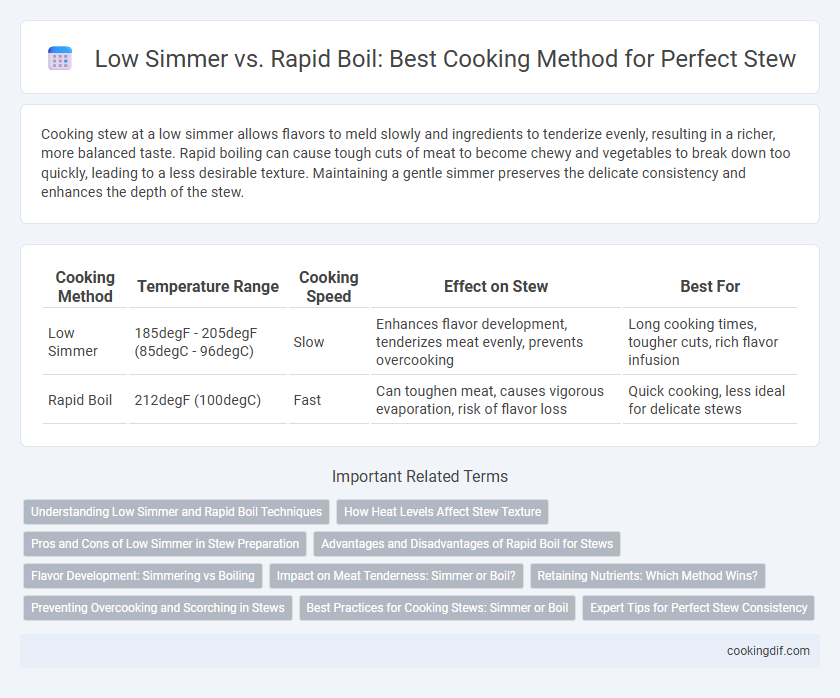Cooking stew at a low simmer allows flavors to meld slowly and ingredients to tenderize evenly, resulting in a richer, more balanced taste. Rapid boiling can cause tough cuts of meat to become chewy and vegetables to break down too quickly, leading to a less desirable texture. Maintaining a gentle simmer preserves the delicate consistency and enhances the depth of the stew.
Table of Comparison
| Cooking Method | Temperature Range | Cooking Speed | Effect on Stew | Best For |
|---|---|---|---|---|
| Low Simmer | 185degF - 205degF (85degC - 96degC) | Slow | Enhances flavor development, tenderizes meat evenly, prevents overcooking | Long cooking times, tougher cuts, rich flavor infusion |
| Rapid Boil | 212degF (100degC) | Fast | Can toughen meat, causes vigorous evaporation, risk of flavor loss | Quick cooking, less ideal for delicate stews |
Understanding Low Simmer and Rapid Boil Techniques
Low simmer involves maintaining a temperature just below boiling, around 185-205degF (85-96degC), which gently cooks stew ingredients, preserving flavors and tenderizing meat without breaking down delicate components. Rapid boil reaches 212degF (100degC), causing vigorous bubbling that can toughen meat and cause liquids to evaporate quickly, often leading to less efficient flavor development in stews. Mastering low simmer techniques ensures slow flavor melding and optimal texture, while rapid boil may be suited for faster thickening but risks compromising stew quality.
How Heat Levels Affect Stew Texture
Low simmering preserves the stew's tender meat fibers and allows collagen to break down into gelatin, resulting in a rich, silky texture. Rapid boiling causes meat proteins to contract aggressively, leading to tougher textures and cloudy broth due to emulsified fats and impurities. Maintaining a steady low heat optimizes flavor melding and creates a smooth, hearty consistency essential for classic stews.
Pros and Cons of Low Simmer in Stew Preparation
Low simmer in stew preparation preserves the tenderness of meat and allows flavors to meld deeply, resulting in a rich and hearty texture. This gentle cooking method minimizes the risk of overcooking or toughening ingredients, making it ideal for tougher cuts like chuck or brisket. However, low simmering requires longer cooking times and careful temperature control to prevent undercooking or extended kitchen use.
Advantages and Disadvantages of Rapid Boil for Stews
Rapid boil accelerates cooking by increasing heat transfer, effectively tenderizing tougher stew ingredients in less time. However, this method can cause meat to toughen and vegetables to break down too quickly, resulting in a less desirable texture and cloudy broth. Rapid boiling also increases evaporation, requiring frequent liquid replenishment to maintain stew consistency and flavor.
Flavor Development: Simmering vs Boiling
Simmering a stew at a low temperature allows flavors to meld and deepen gradually, promoting richer, more complex taste profiles as collagen and fat break down slowly. Rapid boiling agitates ingredients aggressively, which can cause tough cuts of meat to seize and result in a harsher, less integrated flavor. Maintaining a low simmer preserves the stew's aromatics and tenderizes proteins optimally, enhancing overall flavor development far better than boiling.
Impact on Meat Tenderness: Simmer or Boil?
Cooking stew meat at a low simmer allows collagen to break down gradually, resulting in tender, juicy pieces. Rapid boiling causes tough muscle fibers to contract and squeeze out moisture, leading to dry, chewy meat. Maintaining a consistent low simmer is essential for optimal meat tenderness in slow-cooked stews.
Retaining Nutrients: Which Method Wins?
Low simmer preserves more vitamins and minerals in stews by maintaining gentle heat that prevents nutrient breakdown. Rapid boiling can cause water-soluble nutrients such as vitamin C and B vitamins to leach out, reducing the stew's overall nutritional value. Choosing a low simmer method enhances nutrient retention while developing richer flavors in slow-cooked stews.
Preventing Overcooking and Scorching in Stews
Maintaining a low simmer while cooking stew ensures tender meat and vegetables by preventing overcooking and preserving flavor, as rapid boiling can cause tough textures and uneven cooking. A low, gentle simmer allows collagen in meat to break down gradually, resulting in a rich, velvety broth without the risk of scorching the bottom of the pot. Rapid boiling increases the likelihood of burning ingredients and creating a bitter taste, which compromises the overall quality of the stew.
Best Practices for Cooking Stews: Simmer or Boil
Maintaining a low simmer is essential for cooking stews, as it allows flavors to meld and tough cuts of meat to become tender without breaking down the texture. Rapid boiling can cause proteins to toughen and liquids to evaporate too quickly, leading to a less flavorful and unevenly cooked stew. Gentle simmering ensures steady heat penetration, preserving moisture and enhancing the depth of taste in the final dish.
Expert Tips for Perfect Stew Consistency
Maintaining a low simmer at around 185degF (85degC) allows collagen in tougher cuts to break down slowly, resulting in tender, melt-in-your-mouth stew meat. Rapid boiling, exceeding 212degF (100degC), can toughen protein fibers and cause the liquid to evaporate quickly, leading to uneven cooking and a less flavorful stew. Expert chefs recommend monitoring temperature and stirring gently to achieve a rich, velvety stew consistency without overcooking.
Low simmer vs rapid boil for cooking method Infographic

 cookingdif.com
cookingdif.com